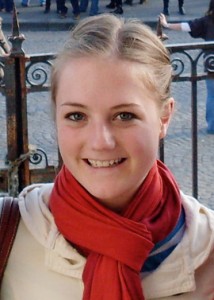Wiedenbeck ’10 Receives NASA-Supported Grant for BA/MA Research

In some models of origins of life, hot springs are considered to be one of the first environments inhabited by life. During the 2010-11 academic year, biology BA/MA student Jane Wiedenbeck ’10 will use a NASA-funded Graduate Fellowship to study the evolution of certain microorganisms to discern how life may have originated and evolved under extreme conditions.
Wiedenbeck, who applied for the fellowship during the fall 2009 semester, received a $20,000 award from the Connecticut Space Grant College Consortium. The Consortium is a member of the NASA-funded national Space Grant College and Fellowship Program, and serves to promote and support NASA aeronautic and space-related research in Connecticut.
Martha Gilmore, associate professor of earth and environmental sciences, and Wesleyan’s liaison for the Connecticut Space Grant, presented the award to Wiedenbeck.
This fellowship will support Wiedenbeck’s research in Professor of Biology Fred Cohan‘s lab on bacterial evolution–specifically the nature and rate of species formation in Bacillus subtilis and hot-spring Roseiflexus. Both model organisms are of particular interest to astrobiology, Wiedenbeck explains.
Bacillus produces an extremely resistant spore, which is believed to be able to withstand the rigors of travel through space, perhaps after being launched into space with dust from an erupting volcano. Thus, if another planet were to be colonized spontaneously by earthly life, Bacillus would be a likely colonist. Roseiflexus is a hot spring bacterium and has the potential to thrive on other planets. Wiedenbeck’s and Cohan’s study will contribute to astrobiology by investigating the dynamics of evolutionary diversification in both these model systems.
Wiedenbeck worked in Cohan’s lab as an undergraduate research student for two years, and she was a Hughes Undergraduate Research fellow one summer. She was recently accepted into the BA/MA program for her fifth year.
“Jane has made significant contributions to my laboratory’s studies on the evolutionary diversification of Bacillus and Roseiflexus, by designing and conducting research and by mentoring other students,” Cohan says. “I am very proud of Jane for earning this award. She and I had designed the research program together, with very significant contributions from Jane. She then wrote the grant proposal on her own, and on her own initiative. She has an excellent grasp of the issues we are studying, and she can communicate to others the importance of her work.”
Wiedenbeck and Cohan are investigating whether bacterial species exist as cohesive populations—that is, whether each species is recurrently purged of its diversity. Over the last half-century, species of all kinds have widely been viewed as cohesive.
The researchers have proposed and are testing an alternative model of evolutionary dynamics, the “species-less” model, where species are formed and are extinguished at very high rates, such that many species are extremely short-lived. The consequence of this short longevity is that diversity within species may be constrained more by a species’ short time on this earth, rather than by cohesive forces that act recurrently over the long lifetime of a species.
Wiedenbeck will study the “species-less” model and characterizes the dynamics of species formation in two model systems of great interest in astrobiology (desert-soil Bacillus and hot spring Roseiflexus). With Cohan, she is surveying the DNA sequence diversity in each system to identify the most newly divergent species.
“Comparisons of genome content, physiology, and habitat preferences of these newly divergent species will reveal the ecological divergences that most frequently drive formation of species in these systems,” Cohan explains. “For example, we will investigate whether newly divergent Roseiflexus species are most likely to diverge in preferences to temperature, vertical depth (and sunlight level), or flow rate.”
They will investigate the issue of cohesion by analyzing the patterns seen in evolutionary trees based on sequence data. If pairs of most closely related species consistently appear as sister species on the tree, for example, like humans and chimpanzees, this will indicate a dynamic of recurrent cohesion within species. If alternatively, most closely related species appear on the tree in a mother-daughter relationship, for example, African and non-African populations of humans, this would indicate that bacterial species are not subject to forces that recurrently limit their diversity.
Weidenbeck will use the fellowship funds to support her project, living expenses during the MA year, and travel funds to attend conferences to present her work.

